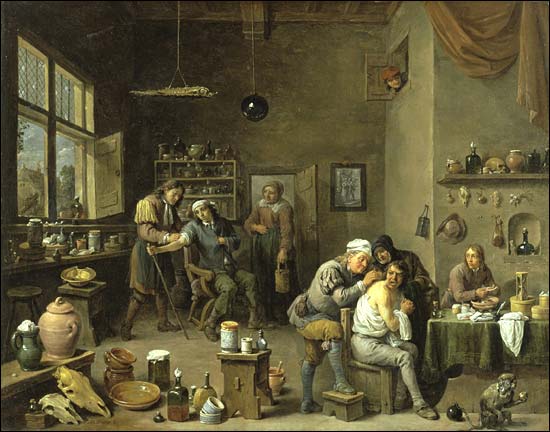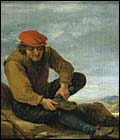The Staatliche Kunsthalle of Karlsruhe presents, for the first time in Germany, one of the great masters of genre painting of the Golden Century in Flanders, David Teniers the Younger. Based on the rich collections of the museum itself, which is one of the most important and oldest in the country, and thanks to exceptional loans from the greatest public and private collections in Europe and the USA, the exhibition presents 140 exceptional works, among them 90 paintings and drawings by Teniers of which a great number have never been shown in public before - as well as paintings by some of his most brilliant forerunners and contemporaries : Adriaen Brouwer (1605/1606-1638), Pieter Brueghel the Younger (1564-1638) and Jan Brueghel the Elder (1568-1625). Some thirty prints based on paintings, as well as three tapestries in the master’s style complete the exhibition.
Genre painter and Court painter
Born in Antwerp in 1610, Teniers did his apprenticeship with his father, David Teniers the Elder, before being named master of Saint Luke’s guild around 1632/1633. In 1637 he married Anna Brueghel, the daughter of Jan Brueghel the Elder. The fiancée’s tutor, and witness of the wedding was none less than Peter Paul Rubens. Though he excelled in painting rural scenes, Teniers frequented high society: He was court painter and the curator of the collections of Archduke Leopold William, the governor of the Southern Netherlands. In 1651, he moved to Brussels where he acceded to high positions in the name of his protector, including the conservation of the Archduke’s important collections. In that capacity, he drew up the Theatrum pictorium in 1660, the first illustrated catalogue of prints of a collection of paintings. He participated actively in the creation of the Beaux-Arts Academy of Antwerp in 1664.
Real life painting
The exhibition in Karlsruhe sheds light on the various phases in the artist’s evolution and the diversity of his work, with works from the most brilliant period of Teniers’ immense production. The painter’s first steps were marked by the influence of Dutch genre painting with its moralizing connotations. With the help of a dark palette, Teniers painted the inside of inns, of cabarets and barns brimming over with life, full of exuberant peasants whose excessiveness and rustic manners he showed and ridiculed. He also sketched with mischievousness and skill patients’ painful encounters with healers and other teeth-pullers, as well as the heavy and disturbing atmosphere of alchemists’ laboratories
A more tender look
Little by little Teniers’ vision of his contemporaries became more tender, his humour less ironic and his palette clearer, with silvery and light filled tones. Everything tends toward gaiety and healthy enjoyment but without any admonitions. He depicts the toiling of the peasants - planting, haymaking, harvesting, wood-cutting, fishing...- as well as their leisure activities - archery, bowls, card games, backgammon etc... As for the women, he shows them at the outdoor washing-place, at the laundry, at the well or busy in the kitchen and of course in their role as mothers.
Illustration: David Teniers the Younger, Landscape with peasant resting Oil on panel, 17,8 x 24 cm, private collection.
Popular festivities and lordly life
A large part of Teniers’ production was devoted to festivities, friendly village celebrations and saucy cabaret scenes. It was in 1637 that he completed his first large Peasant Wedding. These feasts were perfect opportunities for him to deploy colourful crowds out in the open or inside a tavern, with cheerful dancers and guests busy smoking, playing or conversing. As a result he presented paintings of moments of life in an idyllic country, a true Flemish Arcadia. Though he was particularly appreciated for his genre scenes, his animated landscapes, the paintings covering all the seasons, pastoral romances and different subjects represent a large part of Teniers’ activity. From time to time the painter broadened his popular repertoire to depict noblemen strolling or riding through their rich properties or self-portraits with his family. Given the diversity and originality of its content, this retrospective will offer rich discoveries for amateurs and researchers alike.
PUBLICATION
Exhibition catalogue (in German) : Texts by Marcus Dekiert, Margret Klinge, Dietmar Lüdke, Jessica Mack-Andrick and Astrid Reuter. 400 p., with illustrations of all the works on show, of which 90 in colour. Publisher Kehrer Verlag Heidelberg, 28 €.
To see more illustrations, click on VERSION FRANCAISE at the top of this page
| 








